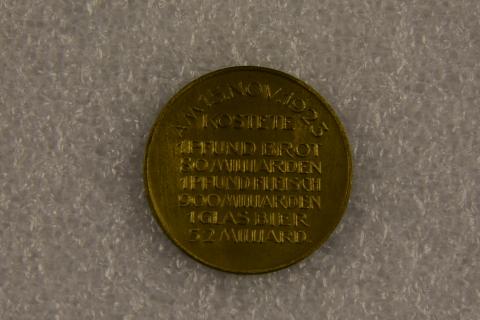This is a golden commemorative coin minted by the Weimar Republic in 1923. It was originally distributed to inform people in Germany about the prices of essential grocery goods at the time. On the front face of the coin is an engraving of a man standing over a kneeling, sobbing woman, with a crying girl at his side. Behind the figures, there is a row of thorn bushes. Above the figures is an inscription that reads, "Des Deutschen Volkes Leidensweg," which translates to "the suffering of the German people" in English. On the rear face is a list of inscriptions detailing the price of three consumer goods: bread, meat, and beer. It says that 1 pound of bread would cost 80,000,000,000 marks; 1 pound of meat would cost 900,000,000,000 marks; and 1 glass of beer would cost 52,000,000,000 marks. This illustrates the extreme financial crisis that Germany was undergoing during the 1920s as a result of the harsh penalties that were levied on the country by the Allied Powers after the end of the First World War. Such economic hardships and hyperinflation drove many into desperate poverty and fuelled the rise of Adolf Hitler and the Nazi Party during the 1930s. This content can be used with the following resources: SS.6.23: Compare Iowa to World SS-Econ.9-12.24: Iowa Economy Impact Upon SS-WH.9-12.26: Iowans Influence World History This content can be used to educate students on the ways in which the larger economic depression that took place during the 1920s and 1930s impacted countries around the world, including the United States. Students can find useful comparisons when comparing the depression in Iowa to the depression in Germany at the same time and what role Iowa had in the larger economic climate. For any use other than instructional resources, please check with the organization that owns this item for any copyright restrictions.
2018.002.039 [Coin]
Legal Status
Copyright to this resource is held by the Iowa Masonic Library and Museum and has been provided here for educational purposes only, specifically for use in the Iowa Museum Association's "Teaching Iowa History" project. It may not be downloaded, reproduced or distributed in any format without written permission from the Rights Holder. For more information on U.S. and International copyright laws, consult an attorney.

